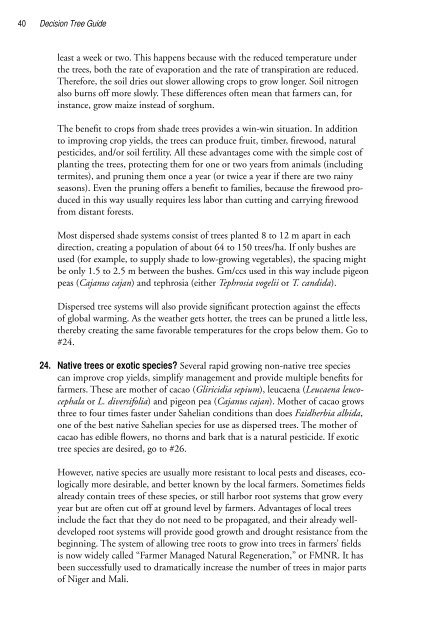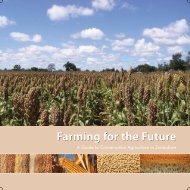Restoring the Soil - Canadian Foodgrains Bank
Restoring the Soil - Canadian Foodgrains Bank
Restoring the Soil - Canadian Foodgrains Bank
Create successful ePaper yourself
Turn your PDF publications into a flip-book with our unique Google optimized e-Paper software.
40Decision Tree Guideleast a week or two. This happens because with <strong>the</strong> reduced temperature under<strong>the</strong> trees, both <strong>the</strong> rate of evaporation and <strong>the</strong> rate of transpiration are reduced.Therefore, <strong>the</strong> soil dries out slower allowing crops to grow longer. <strong>Soil</strong> nitrogenalso burns off more slowly. These differences often mean that farmers can, forinstance, grow maize instead of sorghum.The benefit to crops from shade trees provides a win-win situation. In additionto improving crop yields, <strong>the</strong> trees can produce fruit, timber, firewood, naturalpesticides, and/or soil fertility. All <strong>the</strong>se advantages come with <strong>the</strong> simple cost ofplanting <strong>the</strong> trees, protecting <strong>the</strong>m for one or two years from animals (includingtermites), and pruning <strong>the</strong>m once a year (or twice a year if <strong>the</strong>re are two rainyseasons). Even <strong>the</strong> pruning offers a benefit to families, because <strong>the</strong> firewood producedin this way usually requires less labor than cutting and carrying firewoodfrom distant forests.Most dispersed shade systems consist of trees planted 8 to 12 m apart in eachdirection, creating a population of about 64 to 150 trees/ha. If only bushes areused (for example, to supply shade to low-growing vegetables), <strong>the</strong> spacing mightbe only 1.5 to 2.5 m between <strong>the</strong> bushes. Gm/ccs used in this way include pigeonpeas (Cajanus cajan) and tephrosia (ei<strong>the</strong>r Tephrosia vogelii or T. candida).Dispersed tree systems will also provide significant protection against <strong>the</strong> effectsof global warming. As <strong>the</strong> wea<strong>the</strong>r gets hotter, <strong>the</strong> trees can be pruned a little less,<strong>the</strong>reby creating <strong>the</strong> same favorable temperatures for <strong>the</strong> crops below <strong>the</strong>m. Go to#24.24. Native trees or exotic species? Several rapid growing non-native tree speciescan improve crop yields, simplify management and provide multiple benefits forfarmers. These are mo<strong>the</strong>r of cacao (Gliricidia sepium), leucaena (Leucaena leucocephalaor L. diversifolia) and pigeon pea (Cajanus cajan). Mo<strong>the</strong>r of cacao growsthree to four times faster under Sahelian conditions than does Faidherbia albida,one of <strong>the</strong> best native Sahelian species for use as dispersed trees. The mo<strong>the</strong>r ofcacao has edible flowers, no thorns and bark that is a natural pesticide. If exotictree species are desired, go to #26.However, native species are usually more resistant to local pests and diseases, ecologicallymore desirable, and better known by <strong>the</strong> local farmers. Sometimes fieldsalready contain trees of <strong>the</strong>se species, or still harbor root systems that grow everyyear but are often cut off at ground level by farmers. Advantages of local treesinclude <strong>the</strong> fact that <strong>the</strong>y do not need to be propagated, and <strong>the</strong>ir already welldevelopedroot systems will provide good growth and drought resistance from <strong>the</strong>beginning. The system of allowing tree roots to grow into trees in farmers’ fieldsis now widely called “Farmer Managed Natural Regeneration,” or FMNR. It hasbeen successfully used to dramatically increase <strong>the</strong> number of trees in major partsof Niger and Mali.
















